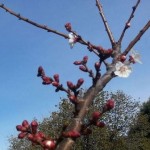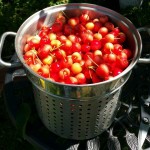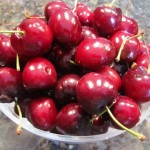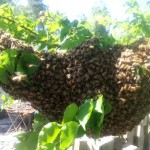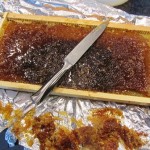Archive for May, 2020
Growing a Bountiful Crop of Sweet Cherries
Cherries are perfectly suited for growing well in our northern California climate. About ten years ago, we planted several sweet cherry trees–Bing, Stella, and Black Tartarian. They’ve proven to be easy trees to grow and reward us with bountiful crops of sweet, ripe cherries around Memorial Day each year.
If you want to grow some sweet cherries, you’ll need to space for a tree or two. Sour cherries will self pollinate but sweet cherries need a pollinator and that means you’ll need to plant two trees 30 to 40 feet apart unless you are growing a dwarf variety. Dwarf trees should be spaced 5 to 10 feet apart. The trees need sun, good air circulation, and well-drained fertile soil. Drainage is important because cherry trees are susceptible to root rot.
Once the trees are established, prune in early spring to remove large limbs or those that are broken, damaged, or too weak to produce fruit. In late summer, a second pruning can be done (this one less aggressive) to open up the canopy and improve air circulation.
A newly planted cherry tree can take three to five years to produce fruit. But you’ll be rewarded when your full-size tree produces 40 to 50 quarts of ripe fruit. In Northern California, cherries ripen from early June to late July.
You’ll be sharing your ripe cherries with the birds unless you use netting over your tree. A bird will peck a single hole in a perfect cherry and then move on, leaving the damaged cherry to rot on the tree. Local wildlife such as opossums and raccoons also enjoy feasting on cherries, climbing the trees to reach the fruit.
Cherries must be picked at the peak of perfection for if they are picked too soon, the fruit will not slowly ripen in your kitchen. Cherries are more perishable than blueberries, so wash and eat them soon after picking. A pit remover makes it easy to remove the stone from the center of the fruit.
Some people prefer sour cherries for making pies and jam and sweet cherries for eating fresh. Preserve cherries after removing the pits by canning in a hot water canner, drying them using a dehydrator, or freezing them.
______________________________________________________________________________
If you enjoy reading about our adventures in country living, check out my Henny Penny Farmette series of cozy mysteries. They’re chocked full of delicious recipes, gardening tips, and insights into keeping chickens and honeybees. Or, learn about how to take better care of yourself with my health, wellness, and spirituality books. All are available online and wherever books are sold.
Keeping Bees Feeds the Family
The sight of bees collecting pollen makes me happy. Always has. Honeybees are vital to the production of the foods we love such as almonds, apples, citrus, melons, and a large variety of vegetables. My vegetable garden and fruit trees are incredibly productive because of my backyard bees. I guess you could say they feed my family through pollination.
Bees are pollinators. Without them there’s a good chance we’d suffer food scarcity on our planet. Three out of four crops around the globe that are foods that we humans eat are dependent in large part on pollinators. Honeybees also produce honey, nature’s most delicious sweetener, in my opinion.
I keep hives of honeybees on my farmette. It’s not a commercial operation but a backyard hobby that supplies honey for my family and friends as well as pollinating a huge variety of vegetables, fruits, and berries that I grow. Caring for the bees is relatively easy. Harvesting honey, on the other hand, is a bit of work but work I am happy to do.
The first step in harvesting honey is to open the hives. The use of a smoker helps calm the bees. Working quickly is a good idea. We never remove all frames of honey from the hive, but rather leave frames with baby bees and some frames with honey so the bees have food, too.
New frames (some are previously used frames that have the wax structure intact) are inserted to replace the removed frames of honey. A super with 10 frames of honey is carried into my kitchen. Inevitably, I have to capture and release a half dozen live bees that ride in on the frames.
Each frame then gets a hot knife slipped just under the layer of wax. With the wax removed from both sides of the frame, only honey is left. This must be spun out or drained off.
I put four frames of honey at a time into the spinning machine in my kitchen. Beneath the machine’s spigot is freshly washed honey bucket, draped with a new cloth strainer that I’ve taped in place over the top of the bucket. It will catch any pieces of wax or other debris.
When the bucket is full, the strained honey is poured into jars to use, store, or give away as gifts. I put a tight-fitting lid on the bucket and keep the bucket within easy reach on the kitchen countertop.
We eat honey year round. I especially love it in the winter because it reminds me of the honey-flow in spring when the farmette smells like honey and my kitchen is saturated with the scent after pulling some frames from the hive.
Also, the vegetables and fruits that I harvest throughout the growing season are either immediately consumed or preserved through hot-water canning, dehydration, flash freezing. I thank Mother Nature for the blessing of bees that pollinate our foods and give us delicious honey from their hive–up to six gallons for ten frames from a full-depth box!
*NOTE: Learn more about honey bees at: https://www.nationalgeographic.com/animals/invertebrates/h/honeybee/
Also, check out: https://honeybeenet.gsfc.nasa.gov/Honeybees.htm
___________________________________________________________
Enjoy reading about country living? Check out my Henny Penny Farmette series of cozy mysteries that also include lists of farm chores, delicious recipes, farm sayings, and tips for healthy living. Or, take a look at my health, wellness, and spirituality books. All are available online and everywhere books are sold.

More than 150 rituals for sound mind, strong body, and meaningful connections to the people around you
 Facebook
Facebook Goodreads
Goodreads LinkedIn
LinkedIn Meera Lester
Meera Lester Twitter
Twitter



